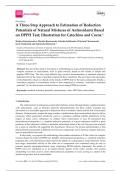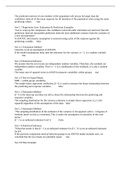Proceedings
A Three-Step Approach to Estimation of Reduction
Potentials of Natural Mixtures of Antioxidants Based
on DPPH Test; Illustration for Catechins and Cocoa †
Barbara Kusznierewicz, Monika Baranowska, Klaudia Suliborska, Wojciech Chrzanowski,
Jacek Namieśnik and Agnieszka Bartoszek *
Faculty of Chemistry, University of Gdansk, 11/12 Narutowicza St, 80-233 Gdansk, Poland;
barbara.kusznierewicz@pg.edu.pl (B.K.); bbmmonik@gmail.com (M.B.); klaudiasuliborska@wp.pl (K.S.);
wojciech.chrzanowski@pg.edu.pl (W.C.); jacek.namiesnik@pg.edu.pl (J.N.)
* Correspondence: agnieszka.bartoszek@pg.edu.pl
† Presented at Natural Products and the Hallmarks of Chronic Diseases—COST Action 16112, Luxemburg,
25–27 March 2019.
Published: 16 April 2019
Abstract: The aim of this study is to propose a methodology to assess electrochemical properties of
complex mixtures of antioxidants, such as plant extracts, based on the results of simple and
popular DPPH test. The first, most difficult step, involves determinations of standard reduction
potentials (E0) for the series of purified compounds (here catechins). The next step is the calculation
of stoichiometric values (n10) based on the results of DPPH test for the same compounds. Finally, a
correlation equation is formulated, which is then employed to estimate “cumulative reduction
potential” (Ec) for the mixture of interest (here cocoa) using DPPH test results.
Keywords: standard reduction potential; stoichiometry value; DPPH test; antioxidants
1. Introduction
The enhancement of endogenous antioxidant defense system through dietary supplementation
with antioxidants, such as bioactive phenolic phytochemicals, has been widely accepted and
advocated as a reasonable approach to reduce the level of oxidative stress and the risk of associated
diseases. Unfortunately, despite the large number of publications about antioxidants, there is still no
consensus which parameters should be used as a guidance enabling reliable predictions of the
impact of redox active substances on cellular redox homeostasis. It may be presumed that
electrochemical properties, i.e., standard reduction potential, of a given substance could be a good
predictor of this substance’s ability to modulate antioxidant status of the cell. Our previous research
for a series of catechins [1] supported this hypothesis. However, the precise determination of this
physicochemical parameter is difficult even for pure compounds, not to mention complex mixtures,
such as antioxidant rich foods.
In this study, we propose the methodology that enables estimation of E0-like value for complex
mixtures based on results of DPPH test. Initially, electrochemical properties, i.e., standard reduction
potentials (E0), were determined which express the ability of a compound to accept electrons. In the
next stage, antioxidant activity of the same set of compounds was evaluated using an easy to
perform popular spectrophotometric assay employing DPPH radicals. Importantly, the results of
DPPH test were calculated so as to include kinetic aspects of the redox reaction. The created
relationship was then used to assess electrochemical properties of cocoa serving as a model of the
actual food product rich in antioxidants.
Proceedings 2019, 11, 4; doi:10.3390/proceedings2019011004 www.mdpi.com/journal/proceedings
, Proceedings 2019, 11, 4 2 of 5
2. Materials and Methods
2.1. Chemicals and Reagents
The following redox active compounds were used for the study: (+)-catechin (C), (−)-epicatechin
(EC), (−)-epigallocatechin (EGC), (−)-epicatechin gallate (ECG), (−)-epigallocatechin gallate (EGCG)
propyl gallate (PG) from Extrasynthese (Lyon, France), L-ascorbic acid (AA), isoascorbic acid (iAA),
sodium ascorbate (NaAA), calcium ascorbate (CaAA) as well as glutathione (GSH) from
Sigma-Aldrich (Saint Louis, MO). Solution of potassium hexacyanoferrate (III) from Sigma-Aldrich
(USA) was applied as a titrant in potentiometric titration. For spectrophotometric tests,
1-diphenyl-2-picrylhydrazyl (DPPH) from Sigma-Aldrich (Saint Louis, MO, USA), analytical grade
ethanol and methanol from POCH (Gliwice, Poland) were used. Tablets of phosphate buffered
saline (PBS) were purchased from Sigma-Aldrich (Saint Louis, MO, USA). PBS solution was
prepared by dissolving one tablet in 200 mL ultrapure water from a Millipore Milli-Q system.
2.2. Standard Reduction Potential by Potentiometric Titration
The determination of standard reduction potentials was performed by potentiometric titration
as described previously [1]. Briefly, potassium hexacyanoferrate (III) was selected as a titrant.
Analysed antioxidants (1 mg/mL) and the titrant were dissolved in PBS (pH = 7.4). Potentiometric
titration was carried out vs. 3 M KCl Ag|AgCl reference electrode and a platinum measuring
electrode at 25, 37 and 41 °C using JENCO 6230 N, ORP-146 C Micro Oxidation-Reduction
equipment (San Diego, CA, USA). Temperature during measurement was maintained by Ultra
Thermostat (PolyScience, Niles, IL, USA), while the temperature of the reaction was controlled in the
range ±0.1 °C using JENCO 6230-AST thermometer. Mixing of the reactants was ensured by
bubbling inert, high purity N2 gas. The titrant was added to the antioxidant solution in increments of
0.5 mL and potential was read after stabilisation. Each potentiometric titration was performed in
three independent repeats. Obtained titration curves (E [mV] vs. Vtitrant [mL]) were analysed by
non-linear regression (Marquardt-Levenberg algorithm) using SigmaPlot (Systat Software Inc.,
London, UK) software. Obtained reduction potentials of tested compounds vs. standard hydrogen
electrode (SHE) were calculated.
2.3. Antioxidant Activity by Spectrophotometic Method
The colorimetric determination of antioxidant activity was performed by standard method
employing DPPH radical as described previously [1]. In short, stock solution of radical was diluted
in methanol before measurement until absorbance reached 0.9 ± 0.05 at 515 nm. All reactions were
carried out in 48-well plates at 25, 37 and 41 °C. Stock solutions of antioxidants were prepared in
analytical grade ethanol at a concentration of 10 mM. Stock solutions of antioxidants were diluted
appropriately with the same solvents to achieve concentrations falling within a linear range of the
assay. The DPPH solution (1 mL) was mixed with solutions of antioxidants (30 μL) and the
absorbance was measured at 515 nm after 10 min. The absorbance measurements were performed
with the use of a TECAN Infinite M200 spectrophotometer (Tecan Group Ltd., Männedorf,
Switzerland).
The results of antioxidant activity evaluations obtained by DPPH test were expressed as
stoichiometry values (n) using modified method [2]. The stoichiometry value was determined as a
regression coefficient, and defined as the slope of concentrations of a radical scavenged vs.
concentrations of the tested antioxidant present in the mixture after 10 min of reaction (n10). The
concentration of radicals scavenged by the tested compound in reaction media was calculated with
the use of the Beer–Lambert–Bouguer law (Beer’s law) according to the equation:
−
= (1)
×





